
Diet plans – a hardy perennial
Well, here we are at Twelfth Night. The decorations are all in their boxes, ready to be moved to the loft sometime in February – a good three months before the last of the tree needles can be expected to succumb to the Shark. The bauble-less tree itself will sit on the patio for months as a bonus “touch of green” in the winter garden. Except it will keep getting blown over by the wind and will need setting upright a hundred times before it is finally carted off to the bonfire. The idea of taking it to the zoo to feed the elephants will go the way of all January good intentions.
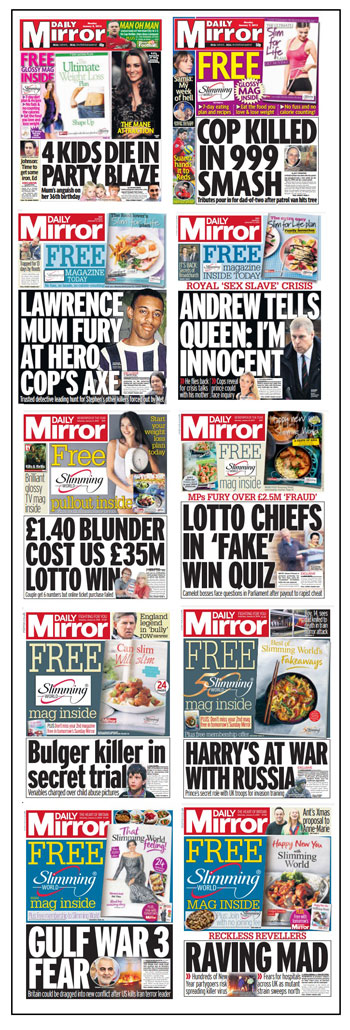
Of those there are many. They – and summer holiday plans – are the lifeblood of features editors across the land in the post-Christmas news desert. There is so much advice to be dispensed on Fresh Starts and New Yous, so many self-help books to sell.
And diets. The hardy perennial of the newspaper calendar. For the Mail, Mirror and Sun at least. Others may venture into this landscape on occasion, but these three never fail. And while the occasional visitors to this world might flirt with fads – from cabbage soup and the F plan from back in the day through Hay, Atkins and Red Wine to the 5:2 and variations on intermittent fasting – the big three are, perhaps surprisingly, generally more wholesome and common-sense based: eat less, but from a wide range of foods; move around more. Simple.
They may dress this up with celebrities and catchy titles, but the message is pretty constant and mainstream. The Mail has embraced intermittent fasting, but this year it has returned to its long-term partner, WeightWatchers. The Mirror meanwhile demonstrates a loyalty that has to be admired, celebrating its 11th successive New Year with Slimming World. And while newspaper design fashions change, some may find it interesting to see here how little has altered in the paper’s approach, particularly over the past five years.
Both the Mail and Mirror tend to focus on women in their promotional material (all three also almost always have “get into shape for summer” and “drop a dress size for the party season” offerings in late spring and autumn), so it was novel to see a bare-chested Joe Wicks on the front page of the Sun, encouraging us to shed the festive pounds at the start of 2016. The formula clearly worked for both and he was the face – or rather body – of the paper’s shaping up schedule for five years. But when Covid and lockdowns struck, Wicks found more pressing calls on his time and the Sun had to look elsewhere for its dietary inspiration. This year, it has teamed up with greengrocer turned never-off-the-telly star Gregg Wallace.
Whoever would have thought that a weight-loss spread would tell readers that it’s not only ok, but desirable, to go for a Greggs.
They may dress this up with celebrities and catchy titles, but the message is pretty constant and mainstream.
Rebel: keeping it off
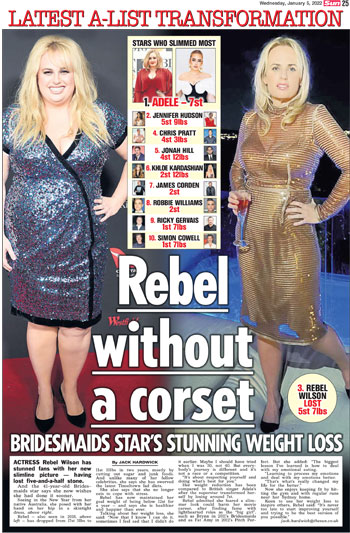
All this advice is naturally all about helping readers to improve their health and feel good about themselves. It has nothing to do with prurience or fat shaming, has it?
I guess, therefore, that the Sun would describe this page in yesterday’s paper as a “celebration” of celebrity success.
Who doesn’t love Rebel Wilson, the Australian actress who just oozes warmth and has for years appeared to be the epitome of someone comfortable in their own skin? Well now there’s rather less of her – five and a half stone less of her, according to the Sun – than we are used to seeing. And apparently this is a genuine transformation rather than the clickbaity “You won’t believe what Rebel Wilson looks like now” cons on social media feeds.
Well done her. And I expect the chief sub was saying “well done” to whoever wrote the headline, which you have to admit is quite a good pun, even if you find it a bit off. Which I think I do.
The package is completed with a league table of other shrinking celebs, topped by Adele with a 7st loss, while Simon Cowell comes in at number 10 on a stone and a half. Strangely, there is no place for Gregg Wallace, who had previously been hailed on the front page for losing four and a half, which should put him above Khloe Kardashian. Maybe he isn’t famous enough.
But there is an even more puzzling aspect to this page than the absence of any reference to the paper’s latest diet guru: why is it there at all?
“Rebel has stunned fans with her new slimline picture,” says the text. “She saw in the new year, posing with hand on hip in a skintight dress” (because we couldn’t see that hand on that hip or notice the fit of the dress). The pose is compared with a similar one from 2018. All right, such “before and after diet” shots are par for the course. It took the actress two years to slim down, the story continues. Slow and steady. Good. And now she has “maintained her goal weight for a year”. Excuse me? This story, if not the gold dress picture, is a year old?
You could argue that it is actually better to see a dieter still at target weight a year after their dramatic loss as it suggests a long-term change to a healthier lifestyle. Wilson says in the copy that she is keen to inspire others. So that would work, if combined with some reference to the Sun’s own diet series (now finished) or even to the “eat more veg” special on the very next page. But the headlines and the panel all give the lie to that ethos. It’s just another opportunity to gawp and judge.
Excuse me? This story, if not the gold dress picture, is a year old?
Flesh fest

And there was a lot of gawping in yesterday’s Sun. The page 3 days have long gone, but the paper is still throwing in titillating pictures at every opportunity.
The dominant front-page image yesterday was one of the Apprentice wannabes in a revealing one-piece swimsuit to illustrate a puff likening the show to Love Island. This, naturally, required a drop-in image from that show with a lot of flesh in evidence. Page 3 brought a woman in a bikini; page 7 two pictures of a topless Rita Ora in faux-demure poses, and Jane Moore’s page 13 column had the model Izabel Goulart virtually naked practising a yoga posture on a beach with her boyfriend. Then came the Apprentice spread with the front-page candidate in her swimsuit again, along with a rival in a boob-revealing dress. The Bizarre spread on 22-23 had a huge picture of Hailey Bieber (Justin’s wife) in a bikini and snow boots; Rebel without a corset arrives on 25, followed by the “fruity veg” page illustrated by a woman in bra and pants under an open shirt slicing cucumber while being caressed by a topless man. Then on page 27 we have Amanda Holden in sunglasses walking down the street holding an umbrella. She’s covering all bases, the text tells us. Except she isn’t. She is “also wearing a cut-out blouse”, through which her nipples are clearly visible. Which is, one suspects, the only reason the picture is in print.
The Fab Daily spread on 36-37 brings further flashes of flesh. And when you need to illustrate the dry old world of business and finance? Why not go for Dua Lipa bursting out of the top of a dress that shows off her stocking tops?
But never let it be said that the Sun objectifies women. After all, every single one of them posed for these photographs.
The page 3 days have long gone, but the paper is still throwing in titillating pictures at every opportunity.
Covid – an intractable divide
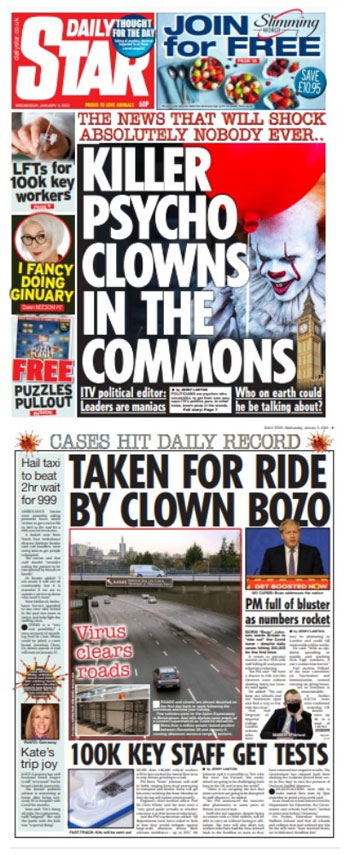
There was, as we see, room on that front page for the latest good cheer from Planet Covid. Not that daily infections had hit a record 218,000 – which was quite something to see at the top of a Sun front page – but that the Prime Minister was confident we would “ride the wave”, that no new curbs would be introduced. The Express and Times also took Boris Johnson at his word, the Guardian had him admitting the NHS could be overwhelmed, the Mirror homed in on pressures on the ambulance service, while the Telegraph and i thought testing was the key issue. The Mail was more concerned about Tony Blair’s knighthood, but Sarah Vine threatened to march on Downing Street if schools were closed again.
To a cynical eye, this might look like simply a change of route to a desired destination, given that her new personal circumstances have blocked her preferred approach road. Yes, that’s cruel. But so, frequently, is Vine and that sort of headline is intended to provoke.
The Star, meanwhile, produced one of its trademark clown front pages. Was this an assessment of the approach to the coronavirus? Nope, it was a disguised puff for Robert Peston’s book. But when you looked inside for the Covid coverage, the conclusion seemed pretty much the same.
Sometimes you have to feel for Boris Johnson. He may be the architect of many of his misfortunes, but he wasn’t to blame for the pandemic and now, two years into it, he – or indeed any prime minister – is incapable of getting it “right”. Because there are so many differing views of what is “right”. For the Mail, Telegraph and Sun, everyone should be back at their desks, maskless, carrying on as normal. The Guardian and Mirror feel that is too gung-ho. The Times and i try to keep a balance, while the Express will just – as ever – go along with whatever “Boris” says and tell readers it’s all for the best.
The “open up the economy” hardliners are putting all their faith in the vaccination programme, and don’t seem much bothered about whether people fall ill so long as the trains keep running, the sandwich bars are still serving and they can go down the pub. Some people will be very ill, need hospital treatment or even die, but that is in the nature of things. If you’re vulnerable, you should stay indoors and take responsibility for your own health and wellbeing. We’ve turned into a nation of state-sponsored hypochondriac malingerers; Omicron is just a fancy-handled dose of the sniffles.
Everyone else seems to think that other measures are necessary both to protect the vulnerable and workers / services. The two sides are as intractable and as divided as Leavers and Remainers were over Brexit, with a mutual disdain for Piers Corbyn and his anti-vax fellow travellers the only common ground.
The two sides are as intractable and as divided as Leavers and Remainers were over Brexit.
Words matter
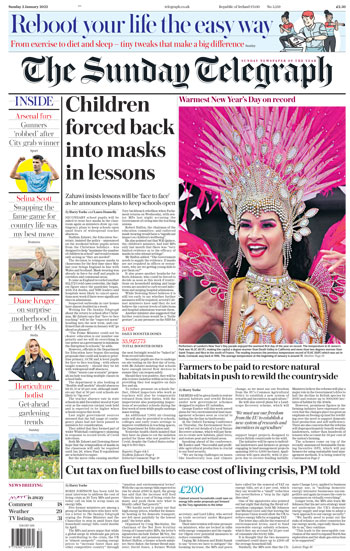
I do understand where the Mail and Telegraph are coming from, but I don’t agree with where they’re ending up.
When you’re running a department, staff illness is a big issue. There are people who will struggle in, no matter how close to their deathbed they appear to be, while others have an endless succession of bugs, infections and medical / personal emergencies. Both are a complete pain. The martyrs come in and infect everyone so that you have to deal with a dozen gaps in the rota rather than just one person off for a couple of days; the hypochondriacs make everyone else cross and can engender a “take a sickie” culture where others think “if it’s ok for Fred… it’s my first day off sick in xx years…”
Then there is after-weekend, after-holiday syndrome. To call in sick on a Monday looks suspicious; you risk being branded either a martyr or a malingerer. As a rota manager, I would prefer people to stay away from the first sniffle to avoid causing bigger problems down the line; as a night editor needing staff to get the paper out, I’d prefer that they turn up, if only for half a shift. This is what happens when staffing levels have been cut to the bone – as has happened across Fleet Street and across the NHS and other public services.
The Mail and Telegraph clearly think everyone who can be at work should be at work; they aren’t railing just against the isolation rules for those without symptoms, they are suggesting that people who have only a “bit of a cold” should soldier on – even though they could infect people and make them really, really sick. For these papers, it’s a question of mathematics, of the “solution” creating greater difficulties than the initial problem
I am not 100% convinced that they are misguided, but I do wish that the Telegraph in particular would pay more heed to the language it uses to press its case. I found both the Sunday splash headline “Children forced back into masks” and the Tuesday leader headline “Absenteeism is crippling Britain” misjudged. To require someone to do something quite simple for their own and greater good is not the same as “forcing” them to do something onerous. And absenteeism isn’t an issue at all. Absenteeism is when people are regularly away from work for no good reason (like the bug-magnet/personal crises people above). If the country is grinding to a halt, it is because people are obeying the rules and staying at home when told to. That is not absenteeism. When your business is words, you should at least choose the right ones.
I do wish that the Telegraph in particular would pay more heed to the language it uses to press its case.
Mask-wearing: for and against

Mask-wearing is clearly a problem for the Telegraph. Yesterday’s front page had a young lad in class looking glum. Maybe he was bored by the lesson, but the inference was that he was fed up with having to have a face-covering.
So may I commend to the folk in Buckingham Palace Road Dr Mark Porter’s explanation of the rationale for them in Tuesday’s Times – and, by extension, the Twitter thread by Dr Trisha Greenhalgh (@trishgreenhalgh) from last July. It made sense then. It still does now.
Does colour impact how we report tragedy?
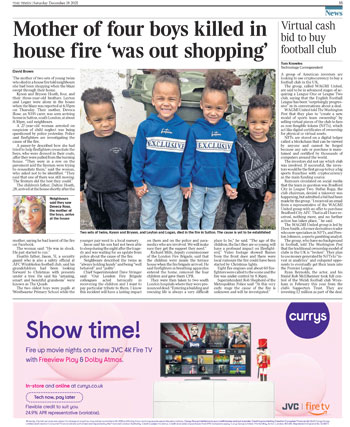
Looking back at that selection of Mirror front pages at the top of this Notebook, it is not only the diets and the holidays that are recurring themes. The first of the pages has the splash “Four kids die in party blaze”. A two-year-old girl, her four-year-old twin sisters and 19-year-old brother were killed, trapped upstairs, when fire tore through their home while their mother was celebrating her birthday downstairs. It was a tragic story, but not so unusual. “Family dies in Glasgow tenement fire” has been a sad Christmas staple for decades.
It takes something really out of the ordinary to move such events up the news schedule. And I would suggest that the deaths of two sets of twins under the age of five in a fire would satisfy that requirement.
I was surprised, therefore, when I saw that the deaths of four boys in Sutton the week before Christmas merited only page 33 in the Times – the penultimate home news page – and page 27 in the Guardian. That put the story behind the Strictly final, Chris Packham asking people to keep their dogs on leads, a re-run through the life of Margaret Duchess of Argyll, and assorted animal and ballet photos.
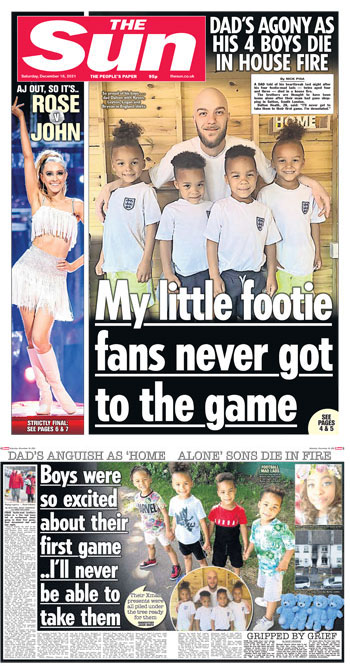
Most of the tabs brought it further forward, but only the Sun thought it worth a splash. It had an exclusive interview with the boys’ father, so an extra “property” – but by the same token, it was at least interested enough in the tragedy to seek it out and publish.
The whole thing troubled me. A respected former colleague suggested that not only was page 33 a perfectly reasonable position, it was perhaps too big a show. He wouldn’t have carried the story at all because it told us little about the state of the world and thus became prurient. I do think it tells us something about society – and it will tell us more when future trials and inquests take place. Questions will be asked about whether such families receive adequate support; there will be those who point at yet another downside of lockdowns and Covid restrictions.
But all of that is for the future. For now, the thing that keeps troubling me is the notion that everyone beyond the Sun would have been far more interested in the children’s fate if they had looked like this:

Black lives matter
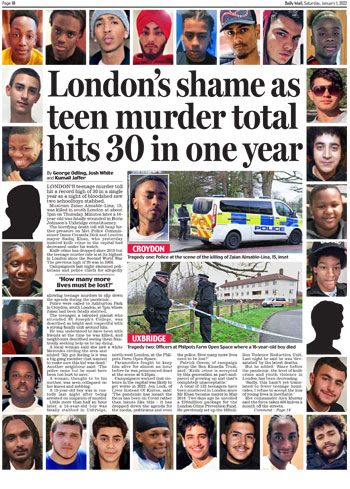
The fraught question of how much non-white lives matter to our media is one that refuses to go away, no matter how often or how loudly editors insist that they are not racist. This week, the Mail carried a striking page on the record number of teenagers killed in London last year – 30 young lives lost, almost all victims of knife crime and not a white British face among them. The story was occasioned by two more murders, thirty minutes apart, in Croydon and Uxbridge.
Well done the Mail? Well, yes. Except that this was not a story about the dead schoolboys or the other victims, but about “London’s shame”, about the pressure on Sadiq Khan and Cressida Dick – neither of whom, I’d wager, was on the Derry Street Christmas card list. The attitude was reinforced in a leader describing the crime rate as “an appalling indictment” of the hand-wringing mayor. For some reason, the Home Secretary – who presumably also carries some responsibility for law and order – was not criticised, or, indeed, even mentioned.
The paper is right that there are issues that need to be addressed. It is also right that the crime rate was much lower under Boris Johnson’s mayoralty. But if it were really concerned, could the Mail not take the trouble to name the victims in its photo gallery?
Still, it did more than most. Only the Mirror and the Guardian joined them in running all the photographs, or as many as they could source. The Mirror gave them all names – albeit under the unfortunate headline “Kill City”.

But it was the Guardian here who showed how it should be done with a proper spread, telling us a little about every victim and the circumstances of their death.
Once again, I would suggest that this would be par for the course if these were white schoolchildren. But, of course, if these were all white schoolchildren, it would be far, far more unusual and hence by at least one definition more newsworthy – though no more troubling.
As I say, fraught questions.
The Colston Four

These were the sorts of issues the jury in the trial of the Colston Four had to grapple with. Their verdict yesterday that the people who toppled the statue of slave trader Edward Colston in Bristol last year were not guilty of criminal damage had the leader writers spluttering. Where will it end? asked the Express. A common concern was that any public edifice might now be vulnerable to attack, that the verdict was tantamount to a licence to vandalise and a threat to the rule of law.
I have to say I was surprised by the verdict. The four had pulled down the statue and thrown it into the harbour. They admitted as much. Surely it was an open-and-shut case. But I hadn’t been following the case closely. I didn’t know what the defence was; that, yes, they had damaged the statue – but not criminally.
The prosecution had argued that Colston’s record was irrelevant. The defence case, bolstered by evidence from the historian David Olusoga, was that the statue itself represented a hate crime. And, to boot, the protesters had increased rather than reduced its value, since the statue was now on display elsewhere with far more context. How could someone be guilty of criminal damage when they had enhanced its worth?
The jurors chose to agree with the defence interpretation. Former Sun editor Kelvin MacKenzie didn’t mince his words in response, declaring that he could not help questioning their sanity. But he hadn’t been in court for two weeks as they had. Nor, indeed, had Labour MP Clive Lewis, who cheered the result.
And nor, for the most part, had the papers that were so exercised this morning. Most had reported that the four were going on trial, a few outlined the prosecution argument – that it was not Colston who was on trial. The Times, Telegraph and Express returned to the case on occasion, reporting that one of the defendants described the protest as “an act of love” and that another felt he was passing a “death sentence” on Colston for abusing his ancestors. Olusoga’s appearance stirred a little more interest. But only the Guardian followed it all the way through; only the Guardian reported Tuesday’s closing speeches.
This case is clearly divisive. Editors and leader writers are, as ever, at liberty to take their view. But before doing so, shouldn’t they have paid more attention to what was going on in court and have shared that information with their readers, rather than catch up after the event?
And as for the Mail declaring “the law is an ass again”. It’s not. Jury trial is, as the Telegraph reminds us, a cornerstone of democracy. Sometimes juries – and, famously, judges – make decisions we disagree with. Isn’t it time the paper came to terms with that?
Jury trial is, as the Telegraph reminds us, a cornerstone of democracy.
Sir Tony

The Mail does seem to be suffering some kind of constitutional confusion. We see it today with juries and we’ve seen it for the past week on the Queen’s role in the honours system. The paper is very exercised by the knighthood for Tony Blair. (So, in fairness, are others – The Blair Ditch Project is the splash in the Star this morning.) Hundreds of thousands of people have petitioned to have the honour rescinded and the Mail has seemed irritated that the matter won’t be debated in Parliament, even though it has passed the 100,000 trigger.
This is because the decision to make Blair a knight of the Garter is the Queen’s alone. It doesn’t come under the honours committee’s remit. It is in her personal gift. Parliament has no say in the matter. Is there any other way to put it to make that clearer?
Paul Dacre is not a fan of the honours system – one wonders how many times he has turned down a knighthood – and he is not a fan of Tony Blair. So the annoyance of the papers he oversees is understandable. But it is also pointless. The Mail likes things to work the way they should. In knighting Blair, the Queen is – belatedly – following tradition. By declining to do so before now, she created a logjam that is holding up his three successors. It had to be done. Not to do so would have been seen as a political decision – and the Mail has always upheld the view that the monarch should be above politics.
All this was explained by the Telegraph’s Charles Moore, who might seem an unlikely advocate for the elevation of a former Prime Minister he disdained. He concluded that of course Blair should be offered his knighthood – but that he should have said "No thanks".
And then, just to throw another spanner in the works, Con Coughlin – again in the Telegraph – today says that Blair deserves his knighthood not in spite of the Iraq war, but because he helped to bring down Saddam.
Ah yes, Saddam. Remember the toppling of that statue? And the glee with which all the papers now fulminating about the Colston Four put that picture on the front page? Time to find those Iraqis and try them for criminal damage?
The decision to make Blair a knight of the Garter is the Queen’s alone.
Prince Andrew
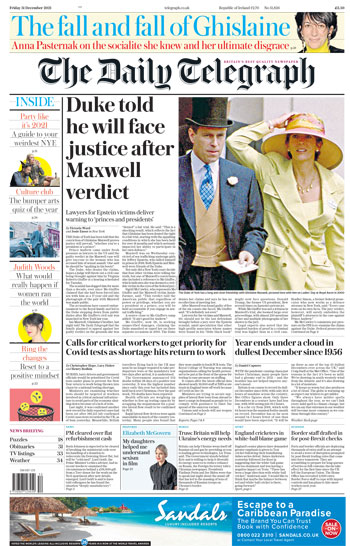
The Queen meanwhile has other things on her mind. Like her “favourite” son and his questionable friendships.
Prince Andrew’s relationship – or otherwise – with Virginia Roberts Giuffre has been causing her angst for more than seven years (it was the splash in one of those front pages in the Mirror montage at the top of the Notebook: “Andrew tells Queen: I’m innocent”) and now we appear to be heading towards the endgame.
The sex-trafficking conviction of Ghislaine Maxwell and the emergence of Giuffre’s $500,000 deal with Epstein have brought the story back to life. But there is a sense of smouldering, of everyone biding their time. Given that various developments have made the splash for the Mail, Telegraph, Mirror and Sun – and the reappearance of that picture everywhere – that may seem odd. But for most, it has been a case of a puff and an early righthander.
The story about how Andrew might be “asked” not to use his “Duke” title if Giuffre is successful in her court case was a sign of this restraint, of a desire, perhaps, not to upset the Queen. What a strange choice of words. Why not go, as the Independent did, for the full-throated “stripped of his title”? It served most papers well enough with regard to the Sussexes – whose sin was not to be involved with pimps and abusers, but to talk to a chat-show host.
As we await the judge’s ruling on whether Giuffre’s case can proceed – the signs are that he will say it can – it feels as though the menacing music from Jaws is playing.
Today there are hints of a settlement. Maybe that is what papers who do not wish to add to the Queen’s grief are hoping for. But I suspect that this story is about to catch fire – and then there’ll be no holding back.
Prince Andrew’s relationship – or otherwise – with Virginia Roberts Giuffre has been causing the Queen angst for more than seven years.
Apology? Kind of.
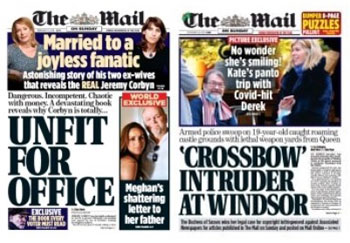
Andrew is obviously the biggest royal story for years – probably since the death of Diana. And it is a great frustration for many that he still seems to get less attention and, more importantly, less approbation, than his nephew and niece. When asked about this apparent bias, I tend to think of it as being asked to compare a James Bond film – bursting on to the scene from time to time accompanied by great sound and fury – to EastEnders that just rolls on and on, week in week out, with occasional attempts at headline-grabbing storylines.
But there is that extra factor: the Sussexes took two things. First they took their ball home and then they took the Press to court. And they won. Or they did on paper.
What a triumph that seemed in May when Meghan won her copyright case and the Mail on Sunday was ordered to print a front-page apology in the same type face as the original offending story. We waited with bated breath. But no apology appeared. The MoS appealed and lost. But the judge agreed that the wording required in the same typeface as the original would take up too much of the front, so that bit of the ruling was changed.
Still we waited. And finally, it was published. On Boxing Day. The day that always has the smallest circulation of the year – and last year it will have been even smaller than usual because the supermarkets, for once, didn’t open. In February 2019, when the offending article was published, the paper had a circulation of just over a million; by November last year – the last ABCs published – the sales were down to 789,000. It will be very interesting to learn just how many copies of that contrition edition, complete with its 64-word “full details” story on page 3, were printed and sold.
Meanwhile, Mail Online was required to publish the apology on its home page for a week. Did the judge think that meant the home screen – the first thing you see when you go to a website? Has he ever looked at Mail Online and seen how deep the home page extends? You had to scroll and scroll and scroll down to find it. And of course the week the Mail chose to publish the apology ran from around midnight on Christmas night through to midnight on New Year’s Eve. Just when addicts were learning to do without their daily sidebar of shame fix.
This is what victory tastes like when you take on the Mail.
And finally, it was published. On Boxing Day. The day that always has the smallest circulation of the year.
Front page of the fortnight
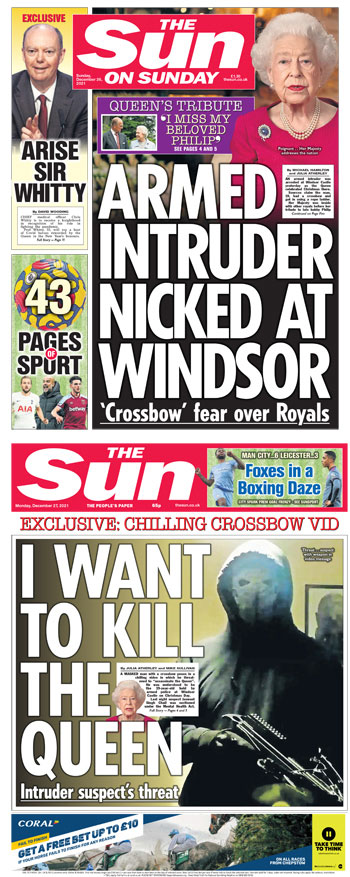
It wasn’t only the Duchess of Sussex whose reach was limited by the holiday. The Windsor intrusion, with its security implications, got hardly any traction. Yet again, the Sun scored with another royal first. The follow-up front page the next day was the more striking, but also more troubling, given that the man in question had by then been sectioned. The page is dramatic, but I don’t think it should have appeared.
And so we welcome 2022 with a slew of royal stories. There will be many more to come, starting with the Duchess of Cambridge’s 40th birthday at the weekend. That bandwagon is already rolling and I’m putting my money on at least one “superb” Mail pull-out supplement on “40 fabulous pictures of Kate looking fabulous at 40”. And then, God willing, the platinum jubilee.
Happy new year.
Liz Gerard’s Notebook is a fortnightly column published in the InPubWeekly newsletter. To be added to the mailing list, enter your email address here.












